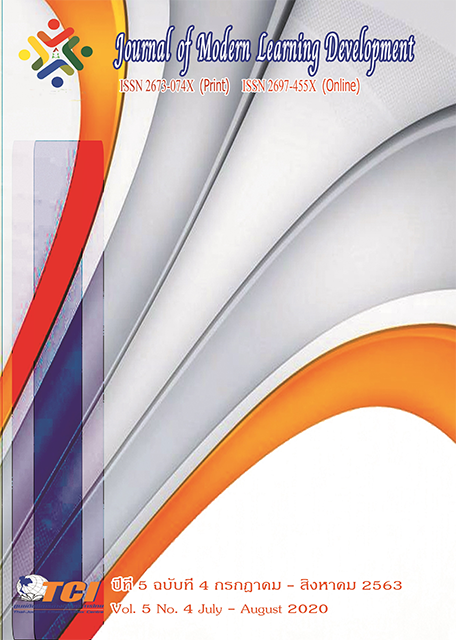The model of life style based on buddhadhamma of hiv-infected peoplein phrabatnampu temple, lopburi province
Main Article Content
Abstract
This research aims were (1) to study state of peoblem of HIV affected people at Wat Phabatnampu Lopburi province (2) to study life style of HIV affected people at Wat Phabatnampu and (3) to present the model ife style of HIV affected people at Wat Phabatnampu Lopburi province. This research is qualitative and field work study.
The results of study were found that the state of HIV affected people ,Wat Phrabatnampu, Lopburi province were divided into 4 aspects 1) body, the outside characteristics clearly appeared i.e. thin the weight was reduced, skin was black and dry the immunity from infected body.2)Mental aspect, the bad mental state, lost heart and felt him/her self useless. 3) social aspect, the HIV affected person felt that he /she was useless, no moral support and no aim of life. 4) Economic aspect, the HIV affected person has no income then no money for spending about food-stuff, especially, the four requisites increased double. Buddhist doctrines in daily life of the HIV affected person i.e. the Threefold training, Sila is principle of social environmental relationship development to have efficiency and proficiency on the mental aspect .Wisdom is knowledge all being things. Analysis and investigation the cause of all things clearly. The Three Characteristics i.e, impermanence, state of suffering and soullessness, the qualitaties of a good friend i. e. good friend ,affection, familiar, generous, a good heart, hope for benefits to oneself and others.
The life style model of the HIV affected person of Wat Phrabatnampu, Lopburi province. The HIV affected person had life style based on Buddha Dhamma doctrines. They brought the Threefold training which is foundation of believers. It begun from the precepts observation by belief that the precepts observation will create a good health, cultivation practice for strong and peaceful mind in fighting against germs. It linked with the Three Characteristics by considering to impermanence, state of suffering and soullessness according to the truth. It withdraw clinging to surroundings, there was no worry if there is a good health. The HIV affected person had a confidence in oneself, be a volunteer to help more weak friends, there was a compassion for others and self-worth.
Article Details
References
เฉลิมพล พลมุข. (2539). จริยธรรมในพระพุทธศาสนากับปัญหาโรคเอดส์ : กรณีศึกษาการดูแลผู้ป่วยโรคเอดส์วัดพระบาทน้ำพุ อำเภอเมือง จังหวัดลพบุรี และโรงพยาบาลบำราศนราดูร อำเภอเมือง จังหวัดนนทบุรี. วิทยานิพนธ์อักษรศาสตร์บัณฑิต. บัณฑิตวิทยาลัย: มหาวิทยาลัยมหิดล.
ประทีป ดวงงาม. (2555). ปัจจัยที่มีผลต่อคุณภาพชีวิตของผู้ติดเชื้อเอชไอวีและผู้ป่วยเอดส์ที่ได้รับยาต้านไวรัสเอชไอวีในโรงพยาบาลชุมชน จังหวัดตรัง. วิทยานิพนธ์หลักสูตรวิทยาศาสตร์มหาบัณฑิต. บัณฑิตวิทยาลัย: มหาวิทยาลัยทักษิณ.
พระปลัดสมชาย ปโยโค(ดำเนิน). (2558). รูปแบบการดูแลผู้ป่วยโรคเรื้อรังเชิงพุทธบูรณาการ. วิทยานิพนธ์พุทธศาสตรดุษฎีบัณฑิต. บัณฑิตวิทยาลัย: มหาจุฬาลงกรณราชวิทยาลัย.
พระมหาภาณุวิชญ์ ปญฺญาปโชโต(บุญคอย). (2555). พุทธวิธีบำบัดโรคทางใจ. วิทยานิพนธ์พุทธศาสตรมหาบัณฑิต. บัณฑิตวิทยาลัย: มหาวิทยาลัยจุฬาลงกรณราชวิทยาลัย.
พระราชวรมุนี (ป.อ. ปยุตฺโต), (2527). พจนานุกรมพุทธศาสตร์ ฉบับประมวลศัพท์. (พิมพ์ครั้งที่ 4). กรุงเทพมหานคร: โรงพิมพ์มหาจุฬาลงกรณ์ราชวิทยาลัย.
วัชรา ทองมอญ. (2541). การศึกษาการนำหลักพุทธธรรมมาประยุกต์ใช้ในการให้การปรึกษาเพื่อลดความเครียดของ ผู้ติดเชื้อเอชไอวี ในโครงการของโรงพยาบาลบำราศนราดูร. วิทยานิพนธ์อักษรศาสตร์บัณฑิต. บัณฑิตวิทยาลัย: มหาวิทยาลัยมหิดล.


